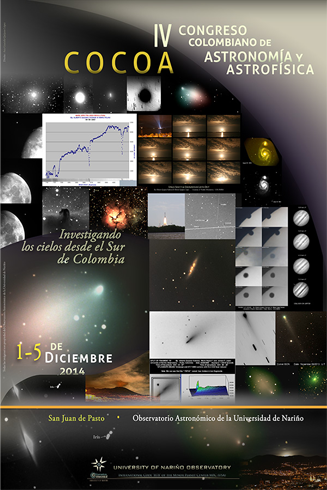Estudio del disco circunestelar de estrellas Be a partir de un análisis espectroscópico en la banda L
Palabras clave:
Estrellas, líneas de emisión, Be, discos, infrarrojo, Stars, emission lines, disks, infrared.Resumen
Las estrellas Be siguen siendo objetos enigmáticos, pues, los mecanismos que originan y regulan la dinámica del disco en este tipo de estrellas permanecen aún bajo estudio. Una forma de explorar esa dinámica es realizar un análisis espectroscópico en el infrarrojo de las líneas de emisión del disco de la estrella Be. En el presente trabajo se presentan nuevos espectros en la banda L (3μm-4μm) de dos estrellas Be del hemisferio norte galáctico, los cuales fueron obtenidos durante el primer semestre de 2014 con el espectrógrafo CID-InSb del telescopio de 2.1 m del observatorio San Pedro Mártir (Insti-tuto de Astronomía de la UNAM, México). Se describirá, asimismo, el proceso de reducción y cali-bración de los espectros infrarrojos, que usa como herramienta, el software IRAF (Image Reduction and Analysis Facility). Estos datos serán utilizados para obtener las razones de intensidades de líneas de Humphreys y Brackett, con el fin de analizar cambios en la profundidad óptica de los discos con la longitud de onda, y detectar los cambios evolutivos que han presentado los discos con respecto a ob-servaciones realizadas en el pasado. Los resultados de esta investigación confirmarán la gran utilidad de los espectros infrarrojos para entender la evolución de los discos circunestelares de las estrellas Be. Estos resultados serán también la base de comparación observacional con los resultados de un futuro modelamiento teórico de la evolución del disco circunestelar en el infrarrojo.
Abstract
Be stars are still enigmatic objects, since the mechanisms that drive and regulate the dynamics of the disks of this type of stars stay still under study. One way to explore that dynamics is to perform a spectroscopic analysis in the infrared of the emission lines produced in the circumstellar disk of the Be star. In this paper, we present new L band spectra (3μm-4μm) of two Be stars of the galactic northern hemisphere, which were obtained during the first half-year of 2014 with CID-InSb spectro-graph at 2.1 m telescope at San Pedro Martir observatory (Institute of Astronomy, UNAM, Mexico). The reduction and calibration process of infrared spectra, using the IRAF (Image Reduction and Analysis Facility) software is also described. These data will be used to obtain the ratios of Hum-phreys and Brackett line intensities, in order to analyze changes in the optical depth of the disks with the wavelength, and detecting evolutionary changes in the disks with respect to observations made in the past. The results of this study will confirm the usefulness of infrared spectra for understanding the
evolution of circumstellar disks of Be stars. These results will be also the basis of observational com-parison with the results of a future theoretical modeling of the evolution of circumstellar disks in the infrared.


